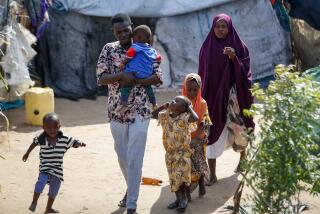The Real Work Will Be Off-Camera : Somalia: The military intervention is a splendid beginning, but this desperate land needs a plan for the future.
- Share via
MOGADISHU, Somalia — No one in this sprawling and divided carcass of a city could have been surprised by the American intervention that began in earnest in Wednesday’s pastel dawn. The local factional radio stations and the Somali service of the BBC--heard in virtually every household--had been broadcasting news of the landing since Tuesday evening.
To the many thousands of Somalis who, like me, had for hours been staring skyward from their roofs and gardens, the spectral silhouette of a helicopter rising was the first visual evidence of a change in their lives, a change whose nature and scope they and we can only begin to grasp.
Those of us who have raged and despaired over the past year as this country has relentlessly consumed itself should be elated. We are, after all, seeing a commitment of human and material resources on a scale and a nature without precedence in the annals of humanitarian assistance, and one that is at last consistent with the dimensions of the tragedy of Somalia.
As I sensed it from my roof through Wednesday’s dawn, that elation was indeed there. But as I made my way later in the morning through the bustle of the town, seeing the near-euphoria on most faces, I began to worry. And as I went from near-normal (at last!) Mogadishu streets into the airport, where the awesome power of massive weaponry was being deployed, my anxiety increased yet more.
Later, as I spoke by satellite to callers in the United States, my anxiety turned to frustration. The overwhelming impression they seemed to have gained is that Wednesday’s unopposed landing has already solved Somalia’s problems. This is hardly the case.
The U.S.-U.N. forces have only barely established themselves on Somali territory. This has all occurred in full view of the world, yet largely out of the sight and knowledge of all but a handful of Somalis.
While convoys of food (followed perhaps by more cameramen than trucks) may bring desperately needed food, this is only a small part of the overall objective of the operation.
From our perspective here, the objective is more than a convoy or two that reaches its goal (though the symbolic importance of this is undoubted). Instead, the objective we must meet is a system of secure and sustainable relief distribution and development--an infinitely more complex and difficult task.
Along with relief distribution we need to create jobs to give the gunmen alternative employment, revitalize agriculture to break out of the current state of dependence on outside food and establish primary health-care programs to reduce deaths from preventable disease.
For this to happen, a measure of legitimate and competent government must be restored; the energies of Somalis themselves--including many of the gunmen who are normal young people--must be found. As I write, another volley of shots has been fired. As usual in Mogadishu, it’s hard to tell who was shooting, or why.
America is now risking the lives of its young people--investing its treasure--to end this madness. The beginning of this process, from the beaches of Mogadishu, was brilliant and heart-lifting.
But no one should confuse the beginning with the long, hard and complex journey that will lead us to the real end: one that will ensure that children can live healthy, secure lives, grow to an adulthood in which they can provide for themselves and in which the creative energies of the Somali nation can flourish. Wednesday was the first momentous step, but the real, and very difficult, task lies ahead.
More to Read
Sign up for Essential California
The most important California stories and recommendations in your inbox every morning.
You may occasionally receive promotional content from the Los Angeles Times.













